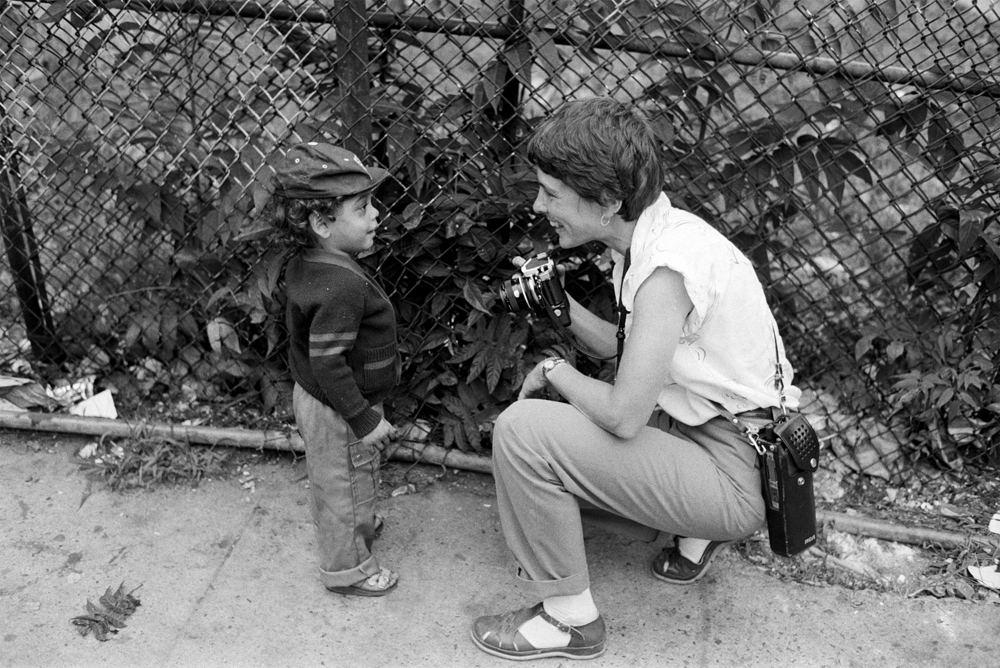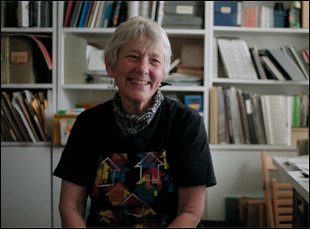Shortly before Selina Miles, the director of “Martha: A Picture Story,” arrives for our interview, Martha Cooper wants to show me some pictures on her iPhone that she took during a recent trip in Haiti.
“So this is a picture from 40 years ago and then this was two weeks ago – they used to make these cars out of metal,” Cooper exclaims, showing parallel pictures of some children playing in the street.
While Cooper seemingly hasn’t aged a day, she has established a unique relationship with time as a photographer, revisiting places she went decades ago to capture how much they’ve changed with her camera, which is often considerable with the traditionally marginalized communities that she trains her lens on. In the underground, her reputation precedes her as Miles shows in the opening minutes of “Martha,” when Cooper accompanies a group of graffiti artists en route to illegally tag up a subway station in Berlin, but just as she gave recognition throughout the years to those whose voice was rarely heard from in the mainstream, the filmmaker bestows the same gift to Cooper, showing how she has preserved the rich cultural histories of the places she’s been that would’ve likely disappeared if she hadn’t been there to witness it, particularly in New York where her seminal book “Subway Art,” co-authored with Henry Chalfant, chronicled street art of the 1970s and 1980s in the five boroughs before it was quite literally erased by gentrification efforts.
It was Cooper’s luck that at the time of publication, 3000 copies of “Subway Art” flew off the shelves, but no one was paying for it, becoming a black market phenomenon that was coveted by those who felt she legitimized their work, and although her own artistry was largely ignored as a result, it became the foundation for generations of graffiti art in the years since. That’s just one of the ways in which Miles finds that the detours life had in store for Cooper led her to a groundbreaking path, initially imagining herself as a National Geographic photographer before learning there was plenty of wild life to chronicle in the U.S., realizing that all the art she was seeing on the sides of subway cars were actually names of people she wanted to meet, all with interesting stories to tell. Relating those local stories to the rest of the world has made her welcome in every corner of the globe, and Miles manages to keep up with Cooper, now in her seventies, as she has developed a real community from those she’s taken pictures of, giving them dignity in a society that undervalues them.
The soulfulness of Cooper’s photos extends to Miles’ profile of her, keeping the circle of colleagues, friends and subjects who speak about her to a select few while the photos she’s taken throughout the years, some presented in parallel, carry immense power in how alive they feel, even as they act as markers of the past. With a lack of pretension that surely ingratiated her to her subjects, Cooper is just as engaging and charismatic shedding light on a remarkable career, even when taking an unnatural position for her — at the center of the frame. Shortly after the premiere of “Martha: A Picture Story,” she and Miles spoke of what it’s like to take a walk down memory lane for someone generally disinclined to look back and now having a keepsake of all that she’s accomplished.
Selina Miles: I’ve been following graffiti as a filmmaker for 10 years and I first encountered it in my hometown of Brisbane, Australia. That’s how I heard about Martha Cooper’s name and her work, so when I met her I was just immediately interested to know more.
Martha Cooper: We met in Tahiti for a street art festival and we became friends in Tahiti, but I saw how hard she worked and how good she was and some of her little YouTube videos and she wanted to do a quick 10-minute video. That sounded like fun, but it turned out to be a much longer one.
Selina Miles: I don’t think either of us could have predicted how this would turn out. I knew Martha and I had been on some adventures before together in the street art festival world, but there was a lot that I didn’t know about her work, particularly the project in Baltimore [which] I think a lot of people that come from the graffiti world don’t have any idea about.
Martha Cooper: She wasn’t the first person to ask to do [a documentary]. It’s just that I’m not very comfortable on that side of the camera. I prefer to be on this side of the camera.
When this gets underway, was there actually anything you felt was important to convey?
Martha Cooper: As Selina said, I really want people to see more of the breadth of my work and not concentrate on graffiti and street art, even though that is what a lot of the film is about. But I think this gives a much broader look at what I’ve been doing for the last 50 years.
Selina Miles: There is a really natural arc to Martha’s story. It was always going to be the story of this book, “Subway Art,” and its inception and then its initial rejection and then its miraculous resurgence later on — a lot of people have referenced “Searching for Sugar Man” in the way that Martha’s success in that world came about. So that was always there, but within that, it’s been a process for me of really distilling 50 years’ worth of work into a watchable 80 minutes. It’s very sad not to include everything. There’s whole projects of Martha’s that I couldn’t include in the film at all, but I really recommend if anyone enjoys the film to go and find out more because there’s so much more to learn really.
The structure for this is particularly well-done. I was surprised to learn midway through that Martha’s parents owned a camera store, which I imagine could’ve been up in the opening minutes, but comes in at just the right moment.
Selina Miles: Yeah, that information used to be at the front of the film and it makes sense for it to be at the beginning because if it’s a retelling of somebody’s life you start at the beginning. But it just means so much more once you’ve understood a little bit more about what Martha went through in those first few decades of her career. You are so much more invested in the back story once you’ve gone through that together. So there was a part of the process that was about finding ways to step outside of just that chronological exposition retelling of events. Once you add the then and now aspect and you’re jumping back and forth in time, it does complicate things further, so you’ve just got to make sure you’re being really clear in the ways that you do it. That was one step in the process.
There is also this amazing film of you from selling the calendars you created. Was there much footage of you actually working?
Martha Cooper: Well, those were by my ex-husband. He just shot them on Super 8. That didn’t bother me. That wasn’t serious filmmaking, but I was surprised to see that because we’d been divorced since ’84, so I knew [Selina] had gotten footage from him, but I didn’t remember what he had. That was fun.
Selina Miles: Those tapes were sitting in his basement in Colorado since the ‘80s, and in amongst those tapes are Super 8 video footage of some of these trains that were painted in the ’80s that I don’t think anyone’s ever seen. They’ve seen Martha’s photographs, but they haven’t seen video footage of these trains and for people that are interested in graffiti history, that’s like striking gold. That was exciting.
Martha Cooper: Also, he shot those B-Boys.
Selina Miles: Yeah, that stuff was all really exciting. It was just such beautiful and intimate material. I was so lucky. It really made the film sing having that visual. We’re very grateful to him. He was very generous.
Martha Cooper: He was an anthropologist, but one of the initial attractions of the two of us was he had an Nikon, he was a good photographer and he shot Super 8.
Selina Miles: Archive was coming in all the time. We were finding archival material right up until a few weeks before our deadline, and just by searching in news archive libraries, [there were] little variations on Martha’s name. So if you ask for Martha Cooper, you get some material, and then you search “Marty Cooper” and all the sudden you get all this new stuff. You’re like, “Gosh.”
Martha Cooper: And I don’t throw a lot away, I like nostalgia. But on the other hand, I like moving forward. I’m not that keen to go backwards. Now I want to move on.
Thinking of living in the moment, those graffiti runs in Berlin were thrilling. Is it difficult to gain enough trust to film an illegal act?
Martha Cooper: We already knew each other so we had established a rapport. I felt comfortable with Selina.
Selina Miles: And I was really lucky with gaining access to some of the other subjects in the film because I think I heard 10 people individually say, “I would do anything for Martha.” And that’s because of the relationship that she’s built over the years. There’s just so much goodwill for her and her work. People really feel indebted to her because of the photographs that she’s taken.
Martha Cooper: But a lot of these people already knew Selina too.
Selina Miles: Yeah, it’s been easier than I think it would with any other subject just because of the relationship that Marty has with all of her subjects.
What was the premiere like?
Selina Miles: I really enjoyed it. For me, sitting in the audience knowing that many of the subjects were there and being an Australian telling a New York story and feeling very beholden to those people and responsible for their story, that was scary. So I was very relieved when people told me that they were happy with the way they were portrayed. And then it was just really fun [because] we premiered on home turf and to be able to have a lot of Martha’s family there and a lot of people that were in the film, that was really nice.
Martha Cooper: People made a big effort to come and that was great.
Selina Miles: Yeah, people come from Copenhagen and-
Martha Cooper: Baltimore.
Selina Miles: San Francisco, Baltimore, yeah, a lot of people made the trip.
Is it surreal to be in a room with all of your subjects from all these pictures taken over the course of your life?
Martha Cooper: It is a little bit. I don’t know if surreal is exactly the word, but it’s odd. But great. I’m very happy that that film exists. Especially because it was so hard to find all that footage. I’m so happy that it got put together in a way that other people can see it forever — as much as anything lasts forever. As long as the world lasts, presumably it will be in an archive, and I like to think that there were some lessons in there for aspiring photographers and just freelancers in general, especially those that live in New York or anybody anywhere that’s trying to make a career out of something they love. I’d like to think that they would feel some hope that they could do it.
“Martha: A Picture Story” does not yet have U.S. distribution.





